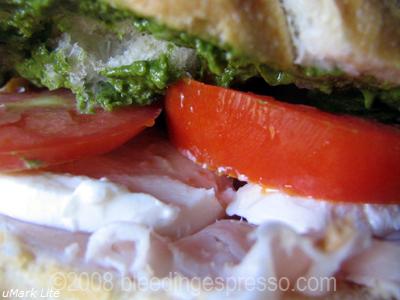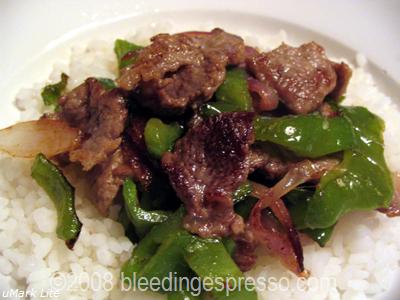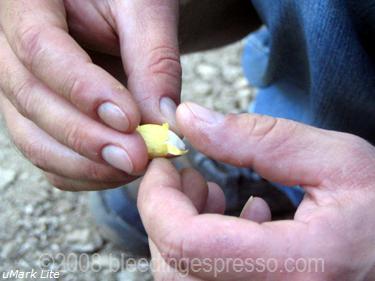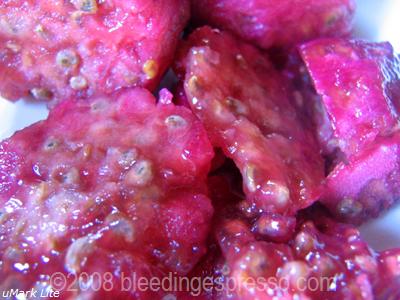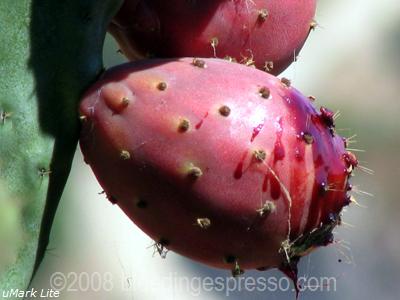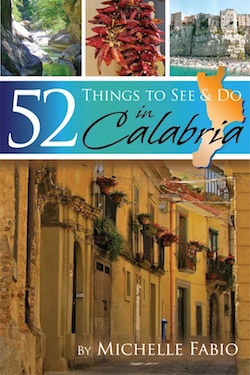Archive for the ‘what’s cooking wednesday’ Category
What’s Cooking Wednesday: Pan-Roasted Quail
 One of P’s friends gifted us with five fresh quail the other day. I know. You wish *you* had friends like that, don’t you?
One of P’s friends gifted us with five fresh quail the other day. I know. You wish *you* had friends like that, don’t you?
I had never prepared or even eaten quail before, so after finding a recipe on the Interwebs, we got down to some quail business for What’s Cooking Wednesday.
This was a great recipe, although we did change a lot to accommodate what we had in the house as well as our tastes. As you can see if you compare the two recipes, we cut the butter, used olive oil instead of vegetable oil, substituted rosemary for sage, and used little pre-prepared cubes of pancetta because that’s what we had. And we also added garlic. But that’s all we changed, I swear!
Overall, I have to say that if we get our hands on some quail again, I’ll definitely make it this way di nuovo, and I hope you’ll try it out too. These little birds were delicious.
Pan-fried Quail
(Quaglia in tegame)
- 5 quail
- 100 grams cubed pancetta
- 5 sprigs of rosemary
- 2 cloves of garlic, peeled
- 2 tablespoons olive oil
- Salt
- Freshly ground black pepper
- 1/2 cup dry white wine
1. Clean and rinse quail thoroughly (P did this part; hopefully yours are already cleaned). Pat dry with a clean towel.
2. Stuff each quail with a sprig of rosemary and some of the pancetta.
3. Heat oil in a frying pan, add garlic and let it cook for just a minute or so–don’t let it even brown, then remove it.
4. Add quail and brown on all sides.
5. Season quail with salt and freshly ground pepper.
6. Turn the quail once, and then add wine. Once the wine has bubbled for a minute or so, lower the heat to medium, cover the pan, and let it simmer for another half hour to forty-five minutes.
7. Check on the pan so it doesn’t dry out; if it does, add some water. You don’t want dry birds.
8. Cook quail until the meat feels tender when poked with a fork.
9. Remove quail from the pan and then turn the heat back up to high. Add about 1/4 cup of water, and scrape up the good quail residual with a wooden spoon and let it mix with the water. Let the water come to a boil, and then pour these juices over the quail before serving.
Buon appetito!
1st of the month featured blogger plus a pesto sandwich
 Yes, today is What’s Cooking Wednesday, but it’s also the first of the month, which means it’s time for a featured blogger, and who better to feature than Shannon of Tales from the Fairy Blogmother, creator and host of What’s Cooking Wednesday?
Yes, today is What’s Cooking Wednesday, but it’s also the first of the month, which means it’s time for a featured blogger, and who better to feature than Shannon of Tales from the Fairy Blogmother, creator and host of What’s Cooking Wednesday?
Shan’s was one of the first blogs I ever read, months before I had one of my own, and since then, I’ve always looked forward to finding out what she and her family (includes two adorable little girls!) are up to. Shan writes about her life as a mom and wife and active fundraiser for many good causes (and so much more!) with such honesty, I can’t help but feel like we just chatted on the phone after reading her posts. And I just *love* when she shares family memories as well.
So what I’m saying is, you should visit Shan on Wednesdays for sure to check out all the lovely WCW recipes, but hang around the rest of the week too, and you’re likely to find yourself wondering what the fam’ is up to this weekend.
(I hope that doesn’t sound creepy Shan, but I really do wish I could come to your parties and family get-togethers!)
Now for those of you who expected a recipe today, I’m going to cheat a bit–I *did* post two recipes last week, you know.
Here is what I had for lunch yesterday:
You want a closer look?
That’s prosciutto cotto, mozzarella, tomatoes, and pesto on a fabulous, fresh “rosetta” roll. The pesto recipe can be found here, and this panino was a great way to use up pesto left over from the previous night’s pasta.
If even after the pesto, you’re still feeling recipe-deprived, be sure to come back Friday when I’ll be posting my part of the O Foods for Ovarian Cancer Awareness Month Contest round-up (including prize winners). Lots of great O Foods coming your way soon, so stay tuned!
what’s cooking wednesday: pepper steak over white rice
 I *loved* my grandmother’s steak hoagies. They weren’t exactly Philly cheesesteaks–they were better. Yeah, I said it.
I *loved* my grandmother’s steak hoagies. They weren’t exactly Philly cheesesteaks–they were better. Yeah, I said it.
The thing is, though, she used “Minute steaks,” which we don’t have here. Do you know them? Frozen, really super-thin slices of meat? Yes, it’s one of those things you can kinda sorta substitute, but still . . . it will just never be exactly the same.
Anyway, I made today’s What’s Cooking Wednesday recipe based on my grandmother’s original recipe, and we’ll get to that in a moment, but for those interested, let me tell you quickly how she made steak hoagies (no measurements because that’s the way she rolled):
- Steam broken up pieces of Minute Steaks in a pan, remove and cover them.
- Heat olive oil and butter in a pan and sauté peppers, then add onions as well.
- Add meat and sprinkle everything with garlic salt.
- Add a small can of tomato sauce and let cook until tomatoes no longer taste raw.
- Stir in cheese (she used slices of Kraft American).
- Serve on a big ole Italian roll. YUM!
Now, fast forward to my craving steak and peppers one night but having no tomatoes (fresh or sauce) or rolls in the house. This is what I made, a simpler, healthier, but still delicious version of an old classic:
Pepper steak over white rice
(serves 2)
- 3 tablespoons olive oil
- 3-4 thin steaks, in bite-sized pieces
- 1 green pepper, cut into strips
- 1 medium onion, cut into strips
- a few shakes of garlic salt
- 1 cup prepared white rice
1. Prepare rice according to package directions.
2. Heat two tablespoons of olive oil in pan, and then add meat, cooking until brown. Remove from pan and cover.
3. Add other tablespoon of olive oil and peppers. Sauté for a few minutes until starting to become tender and then add onions and sauté until tender.
4. Add meat and sprinkle everything with garlic salt, combining well.
5. Let flavors mix together for a minute or so, and then serve over white rice.
Buon appetito!
what’s cooking wednesday: almond joy
 No I’m not making candy bars (but I do love Almond Joys if you’re wondering).
No I’m not making candy bars (but I do love Almond Joys if you’re wondering).
For this What’s Cooking Wednesday, I want to tell you a little more about another of southern Italy’s major crops, the glorious mandorla, or as we know it, the almond.
History of Almonds
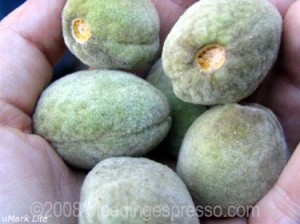 Almonds have been around quite a long time, making guest appearances in the Bible and Greek mythology among other ancient texts. One of the most popular uses of the almond in ancient times was to prevent intoxication, which is why they were often eaten throughout meals during Plutarch’s day.
Almonds have been around quite a long time, making guest appearances in the Bible and Greek mythology among other ancient texts. One of the most popular uses of the almond in ancient times was to prevent intoxication, which is why they were often eaten throughout meals during Plutarch’s day.
Almond trees are native to the Mediterranean region from the Middle East on over; here in southern Italy, almond trees are all over the place, so it’s not surprising that we love and use the almond early and often.
Health Benefits of Almonds
Almonds are one of the healthiest foods around as they can lower LDL (“bad”) cholesterol as well as the risks of diabetes and heart and cardiovascular diseases. They may also help you lose and maintain a healthy weight, increase your energy level, and prevent gallstones. Read more about the health benefits of almonds at The World’s Healthiest Foods.
The Almond in Calabria
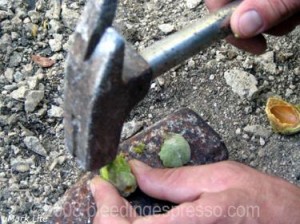 A common drink in Calabria and southern Italy throughout the summer is latte di mandorla or almond milk; almonds release their oils when crushed, and when mixed with milk, make a lovely, refreshing beverage. Many people also add sugar.
A common drink in Calabria and southern Italy throughout the summer is latte di mandorla or almond milk; almonds release their oils when crushed, and when mixed with milk, make a lovely, refreshing beverage. Many people also add sugar.
You will also find that many southern Italian dolci, sweets and desserts, contain almonds–my favorite are amaretti; and if you’re the drinking kind, how about some Amaretto Disaranno Originale? Yum!
And of course we all know of the tradition of giving sugared-coated almonds at weddings and other celebrations.
Not convinced of our passion for the almond yet?
We love the seed of the fruit of the almond tree so much around here, there is even a Calabrese song called Facci de n’ammendula mundata that sings its praises; the singer insists that if offered a pile of gold that weighs more than the almond, he would choose the almond because although the gold will eventually be spent, the beauty of the almond will stay with him forever.
Our Almonds
We happen to have an almond tree in our giardino–remember that P brings me the first almond blossom every year?
Well a few weeks ago when we were down in the garden with the pooches, P picked some almonds fresh off the tree, still in the green furry casings as seen above.
Throughout this post, you can see the process of shelling a fresh almond; after the above photo, P peeled the outer, yellow casing:
And here is the final result in my waiting hand:
Biting into a fresh almond reminded me a lot of crunching a water chestnut: crisp and clean. But then came the gentle flavor of almond and a slightly stronger aftertaste–a lovely, sweet reminder that I had just eaten something fresh, pure, and straight from our tree. Nothing bitter about it.
So what are you going to do with your almonds? I suggest:
- Banana Coconut Almond Bread from Susan at Food Blogga
- Easy Almond Brioche from Susan at Sticky, Gooey, Creamy, Chewy
- Polenta Olive Oil Almond Cake with Peaches in Honey-Basil Syrup from Jenn at The Left Over Queen
And by the way, all of these would go great with a Caffè Shakerato alla Cherrye!
Do you like almonds? What’s your favorite way to enjoy them?
The Skinny on Prickly Pears – Fichi d’India
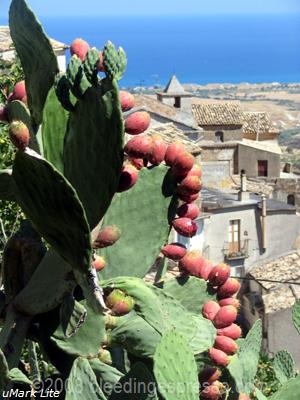 Ever since I published these photos, I know our good friend Gil has been wondering about whether the prickly pears (fichi d’India) are ripe, and well, I’m happy to announce, the time has arrived (see left)!
Ever since I published these photos, I know our good friend Gil has been wondering about whether the prickly pears (fichi d’India) are ripe, and well, I’m happy to announce, the time has arrived (see left)!
So for today’s What’s Cooking Wednesday, a quick lesson in prickly pears.
The prickly pear, or fico d’India in Italian, is the fruit that grows on the end of cacti like in the photo. Those of you in southwestern US and various other hot, cactus-bearing places know this fruit well, I’m sure, but for the rest of you, the most important thing to keep in mind:
DON’T TOUCH THESE WITH BARE HANDS.
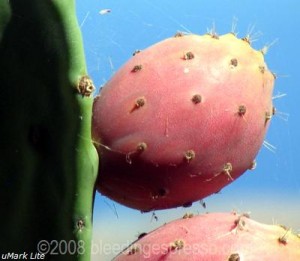 Yeah, the “prickly” in the name might have given you that clue, but it’s not what you think. It’s not the spines on the cactus that are prickly, it’s the tiny, nearly invisible hair-like spines that are *all over* the fruit that cause the trouble–and they are nearly impossible to wash off of you once they’re on. Trust me. It’s like having pins and needles all over your hands, and so not fun.
Yeah, the “prickly” in the name might have given you that clue, but it’s not what you think. It’s not the spines on the cactus that are prickly, it’s the tiny, nearly invisible hair-like spines that are *all over* the fruit that cause the trouble–and they are nearly impossible to wash off of you once they’re on. Trust me. It’s like having pins and needles all over your hands, and so not fun.
Now, I’m not going to lie to you. I don’t clean these. This is P’s job, and although some people soak them in water beforehand is advisable, I’ve never seen him do it. He’s just really, really skilled with a knife, but I still suggest you wear gloves and watch this video to see some pros at work.
For those of you who aren’t familiar with prickly pears, you’re probably wondering what they taste like. Well, um, they’re unique. They’re sweet but not too sweet, kind of a cross between a fig and, I don’t know, a plum maybe?
One thing I can say is that they are very seedy, and no, I don’t mean like from a questionable part of town, I mean like this:
And truth be told, this is my favorite way to eat them. Fresh, seeds and all.
Another popular way to prepare them is in jams or marmalades; you’ll find countless recipes for those with a quick Google search.
But for some unique recipes, check out these from fellow bloggers:
- Prickly Pear Cactus Fruit Vinaigrette from Sara of Ms Adventures in Italy
- Prickly Pear Juice from Ilva of Lucullian Delights
- Prickly Pear Cactus Fruit Salad from Scrumptious Street
- Prickly Pear Granita from Esi of Dishing Up Delights
- And here’s a tutorial on how to clean prickly pears at Vanilla Garlic
Buon appetito!



